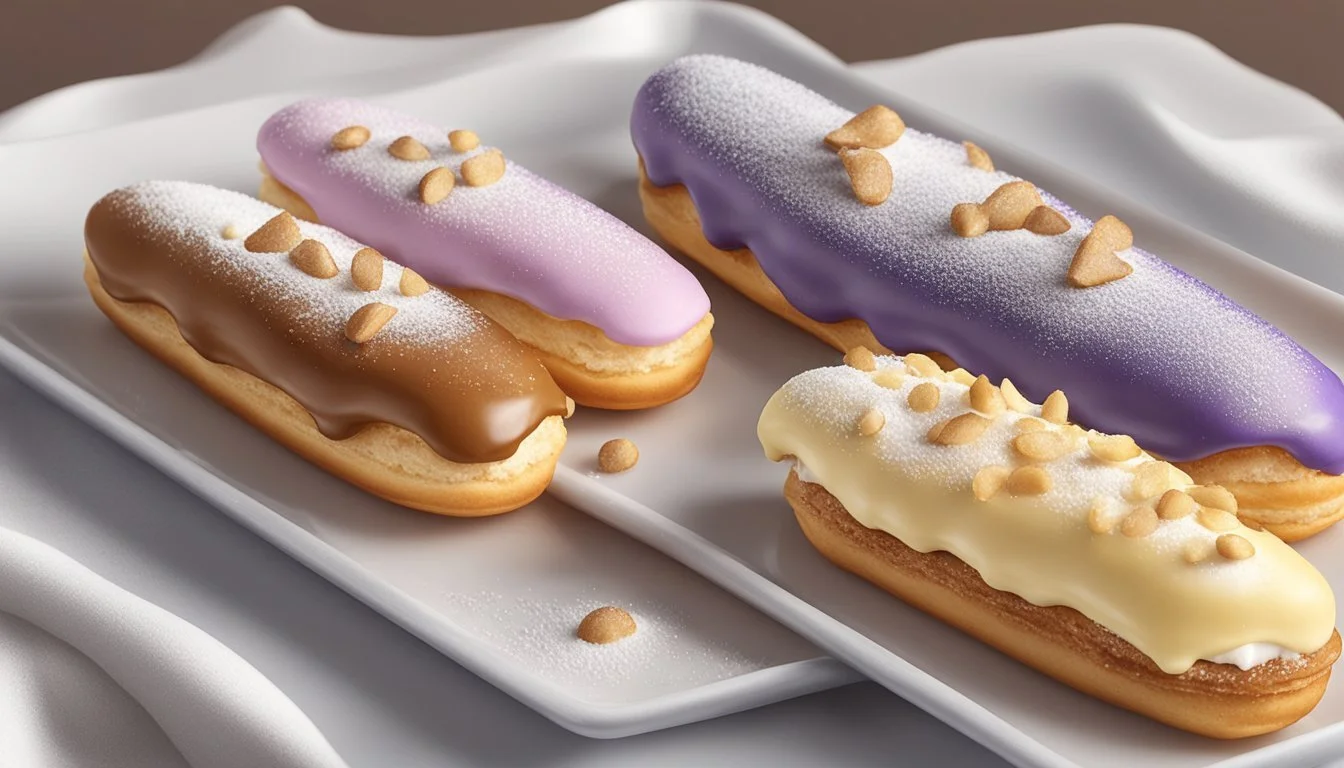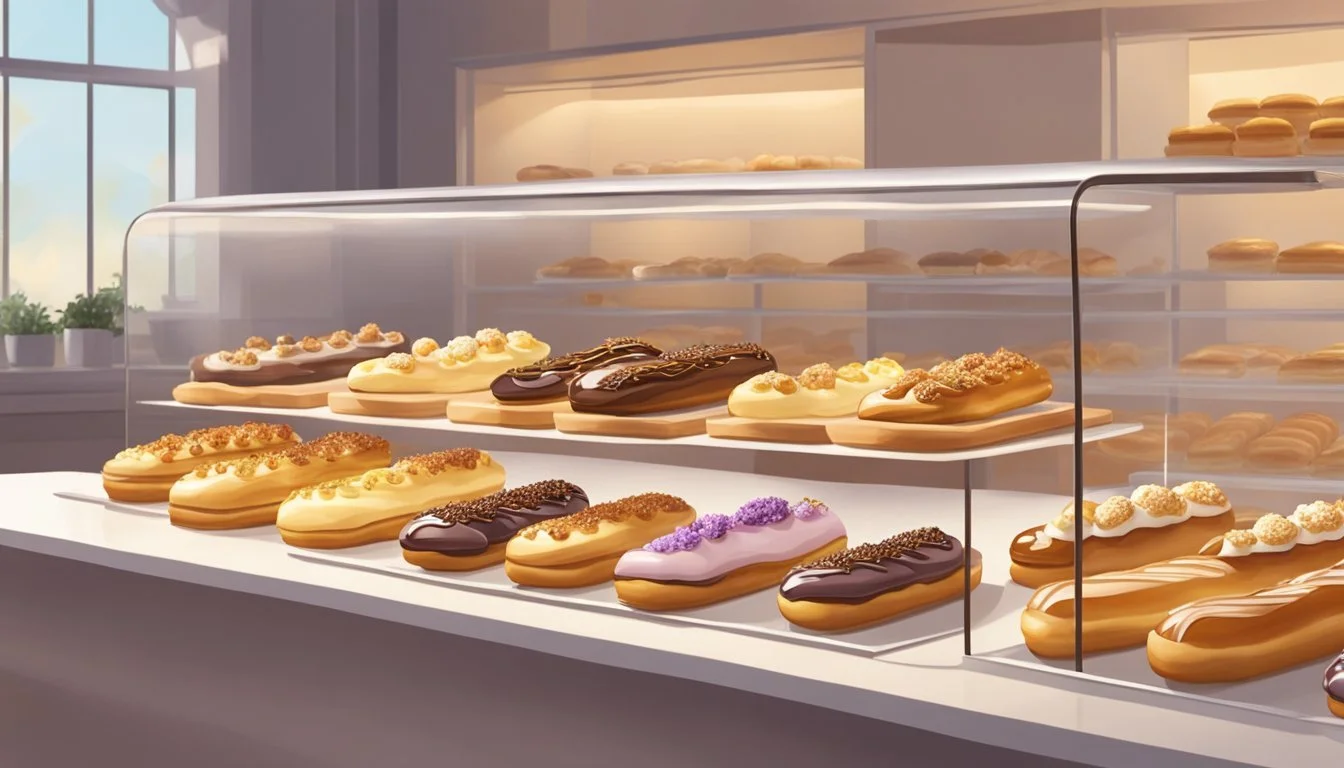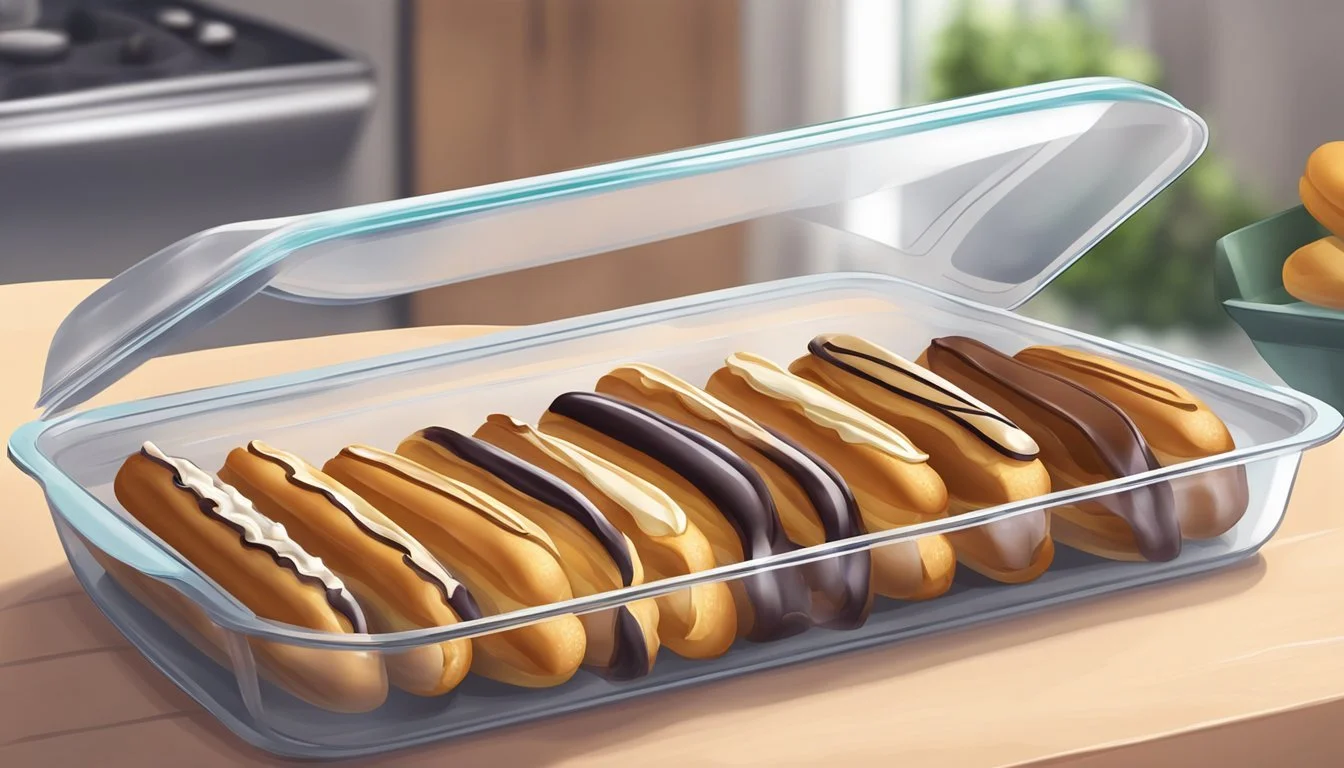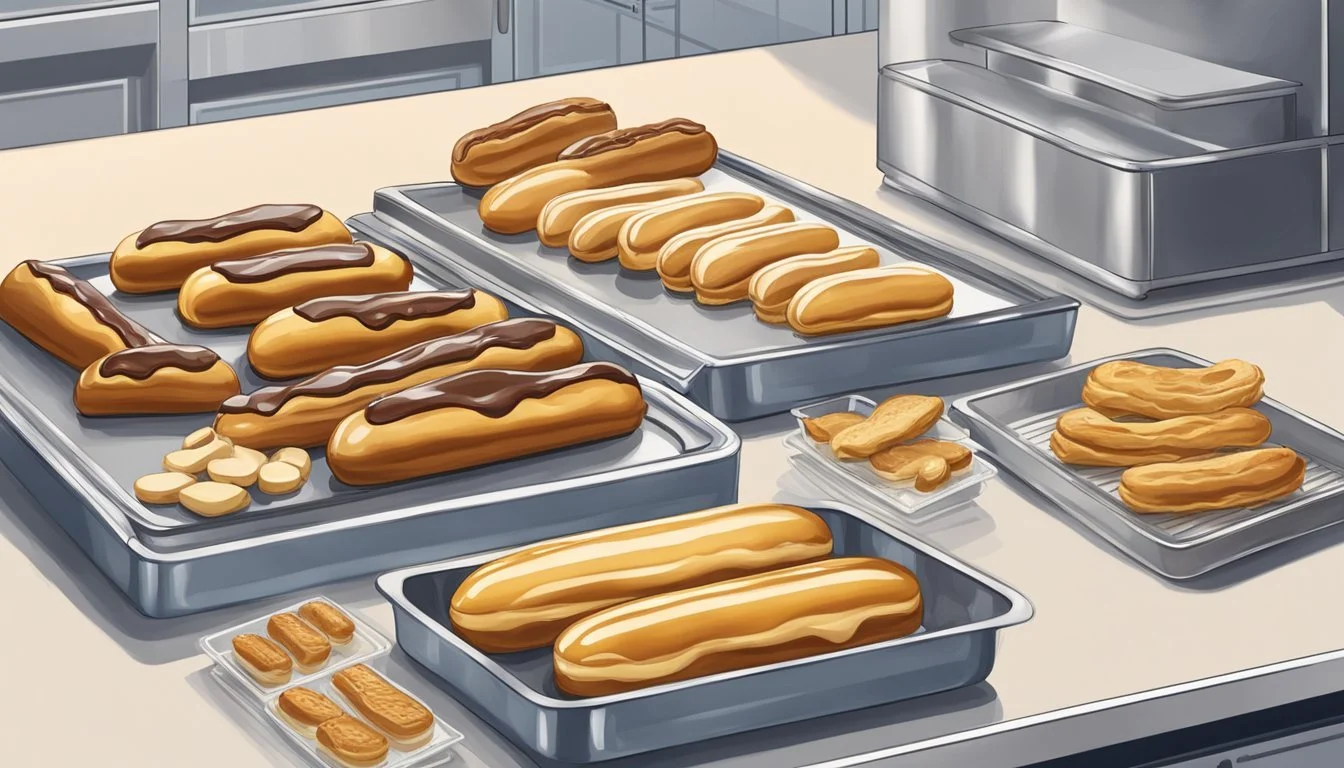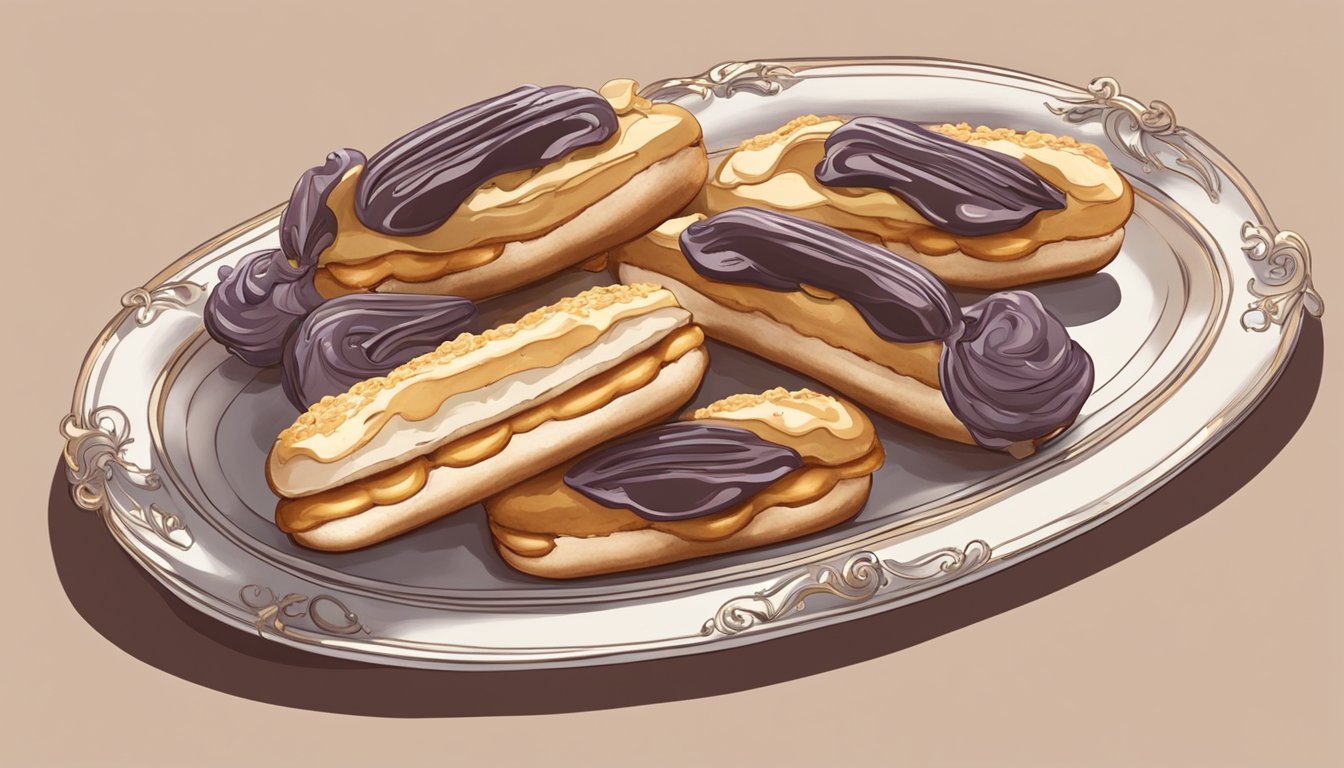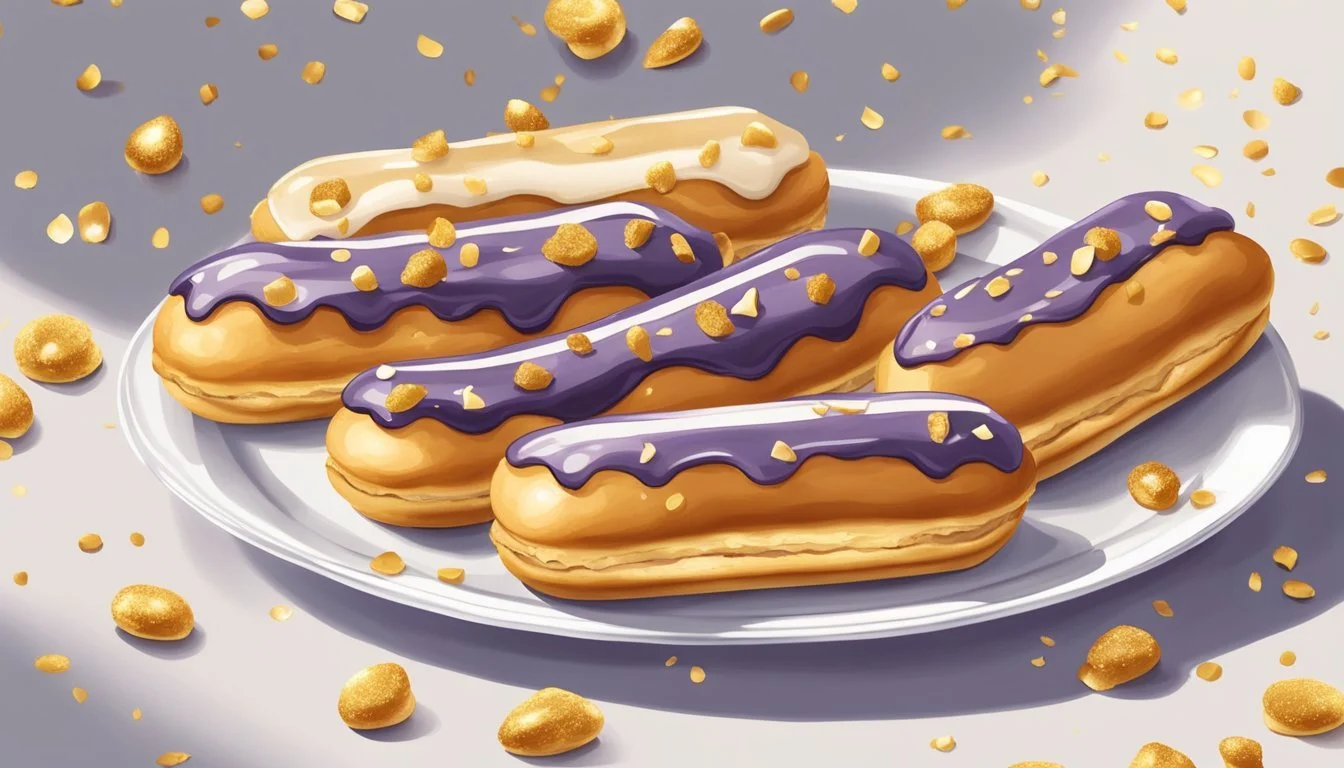How Long Do Freshly Prepared Eclairs Last?
Shelf Life and Storage Tips
Freshly prepared eclairs, with their delicate balance of crisp choux pastry and luxurious cream (how long does cream last?) filling, are a beloved dessert that captivate the palate. The longevity of these pastries is influenced by their preparation and storage. The shelf life of an eclair is a critical consideration for both pastry chefs and dessert enthusiasts.
Eclairs are best enjoyed shortly after they are made, as they are prone to moisture changes that can compromise their texture. To maintain their optimal freshness, they should be stored in a way that addresses both the crispness of the shell and the integrity of the cream. Refrigeration is commonly recommended to preserve the dairy-based filling; however, it simultaneously poses a risk of sogginess to the pastry.
Proper storage techniques are thus pivotal in extending the life of eclairs without sacrificing their quality. An airtight container is often advised to shield the eclairs from humidity and odors in the refrigerator. If storage extends beyond a couple of days, some pastry experts might freeze the shells to prolong their freshness, but this comes with the risk of altering texture upon thawing. Although opinions on the exact shelf life may vary, a general consensus suggests that the window for enjoying the dessert in its prime form ranges from 3 to 4 days under refrigeration.
Understanding Eclairs
Eclairs are a sophisticated and delicate pastry delicacy, each component contributing to their renowned texture and flavor. Proper storage is critical for maintaining their freshness and quality.
Components of Eclairs
Choux Pastry: The foundation of an eclair is the choux pastry, which is light, airy, and should be crisp after baking. This delicate shell houses the filling and serves as the structural base.
Filling: Typically, the inside of an eclair is filled with a rich cream filling, such as vanilla custard or pastry cream, which adds moisture and creaminess to the pastry.
Chocolate Glaze: Often, eclairs are topped with a smooth chocolate glaze that should remain glossy and set, providing a textural contrast to the crisp choux and the soft filling.
Freshness Indicators
Texture: Fresh eclairs display a harmonious contrast between their crisp exterior and the soft interior filling. Sogginess or limpness in the choux pastry often indicates staleness.
Flavor: The flavors of the filling, ranging from sweet vanilla custard to rich chocolate, should be distinct and not tainted by any signs of spoilage or staleness.
By recognizing the importance of each component, one can understand how they all contribute to the character of an eclair and how critical proper storage is to preserve an eclair's best qualities.
Optimal Storage Conditions
For eclairs to maintain freshness and texture, controlling temperature and moisture is essential, as is the use of proper sealing methods.
Temperature and Moisture Control
Temperature: Eclairs should be stored in refrigeration at a consistent temperature to slow down microbial growth and preserve their quality. The ideal temperature range is between 36°F (2°C) and 40°F (4°C). Moisture: Refrigeration also helps to control moisture levels, but eclairs should be kept away from high-humidity areas within the fridge to prevent sogginess.
Airtight Containers and Wrapping Methods
Airtight Containers: Using an airtight container is the best way to protect eclairs from drying out and absorbing odors from the refrigerator. Wrapping Methods: If an airtight container is not available, wrapping eclairs individually in plastic wrap or enclosing them in a plastic bag with excess air removed can be effective. For additional protection, parchment paper can be used to separate layers if eclairs need to be stacked.
Refrigeration vs. Freezing
When preserving the quality of freshly prepared eclairs, one can choose between refrigeration and freezing. Each method affects the eclairs' texture and moisture content differently, necessitating proper techniques to maintain their delectability.
Storing Eclairs in the Refrigerator
Eclairs should be refrigerated if they are to be consumed within a short period. They can last for 3 to 4 days when stored properly. To maintain their texture:
Store in an airtight container.
Wrap tightly with plastic wrap to prevent moisture loss.
Storing the pastry cream and eclair shells separately ensures the shells retain their crispness while the cream remains fresh.
Freezing and Thawing Eclairs
For longer storage, one can freeze eclairs; they will retain quality for 2 to 3 months. To successfully freeze and later enjoy eclairs:
Freeze the eclairs until they are firm.
Transfer to a freezer-safe bag or container.
Label with the date.
To thaw, place the frozen eclairs in the refrigerator, not at room temperature, to manage moisture content and prevent sogginess.
Shelf Life Determinants
The shelf life of freshly prepared eclairs is influenced by their ingredients and the likelihood of spoilage from bacteria and mold. Proper storage decisions can mitigate these factors.
Ingredients Impact on Shelf Life
Ingredients play a pivotal role in determining the shelf life of eclairs. Eclairs consist of a pastry shell, filling, and often a glaze or topping. The main components include milk, eggs, and butter, which are highly perishable. A cream-filled eclair or those that incorporate dairy products have a shorter shelf life because dairy is susceptible to bacterial growth which accelerates spoilage. Eclairs without dairy fillings may last longer when stored properly.
Milk and eggs: critical to pastry cream; refrigerate to slow spoilage.
Butter: stabilizes the structure but can go rancid; keep cool.
Signs of Spoilage and Food Safety
Recognizing spoilage is vital for preventing foodborne illness. An eclair's intricate balance of moisture and delicate ingredients makes it prone to spoilage.
Signs of Spoilage:
Smell: Off odors indicate spoilage.
Mold growth: Visible molds on any part of the eclair is a clear sign.
Texture: Soggy or overly hard shells may imply deterioration.
To maintain food safety standards, one must be cautious of these spoilage indicators to avoid risks of foodborne pathogens. Eclairs are best consumed when fresh and should be scrutinized for freshness before consumption.
Preparation for Longer Shelf Life
To ensure freshly prepared éclairs retain their quality over time, specific techniques during preparation are crucial. The shelf life can be significantly extended through meticulous baking methods and careful assembly and filling choices.
Baking Techniques
Baking is the foundational step that determines the structural integrity of homemade éclairs. A precise baking recipe not only yields the desired flavor but also helps in prolonging shelf life.
Temperature: Bake at the optimal temperature to ensure a crisp shell that holds up against moisture from fillings.
Baking Duration: A perfectly baked éclair will have a dry and hollow interior, which is critical for preventing sogginess after filling.
Assembling and Filling Strategies
Once the éclairs have cooled, attention to detail in assembly and filling further maximizes shelf life.
Pastry Cream: Use thick, stable pastry cream or vanilla pudding as a filling, as it is less likely to weep and soften the éclair shell.
Assembly Timing: Fill the éclairs close to the serving time to minimize moisture migration from the filling to the pastry.
Airtight Storage: Store unfilled shells in an airtight container, and only fill them when ready to serve or as close to that time as possible.
By applying these specific techniques from baking to filling, one ensures the longest possible shelf life for homemade éclairs without compromising texture or taste.
Serving and Consumption
Freshly prepared eclairs offer the best quality in terms of texture and flavor when served shortly after assembly. For optimal enjoyment, they should be consumed when the contrast between the delicate, crisp pastry and the rich, creamy filling, be it whipped cream, ganache, or vanilla custard, is most pronounced.
Thawing and Reheating Tips
When dealing with previously frozen eclairs, one must thaw them properly to maintain quality. To thaw, they should be removed from the freezer and placed in the refrigerator for several hours. If gently reheating is required, it should be done at a low temperature in an oven until just slightly warm. This helps in restoring the eclair's texture without melting the filling.
Best Practices for Presentation
Eclairs should be served at a cool temperature to ensure the filling maintains its structure. Here are best practices for an inviting presentation:
Texture: Ensure eclairs are crispy by serving soon after filling.
Ganache or Glaze: Apply a shiny ganache or glaze to the top for visual appeal and added flavor.
Additions: A light dusting of powdered sugar or cocoa can enhance the visual appeal.
Plating: Serve individually on plates or as part of a dessert platter to avoid them from sticking to each other or getting crushed.
Recipe Variations and Ingredient Substitutions
Eclairs, a delightful pastry dessert, can be customized to suit different dietary needs and taste preferences without compromising their classic charm.
Customizing Eclair Recipes
Eclair recipes are adaptable, allowing for a wide range of flavors and textures. Traditionally, eclairs consist of choux pastry, pastry cream filling, and a chocolate ganache topping. Substituting ingredients within this framework can result in diverse variations.
Pastry Cream: The classic custard filling can be flavored with pure vanilla bean instead of extract for a richer taste. For chocolate lovers, chocolate chips melted into the cream add a luxurious twist.
Ganache: To alter the ganache, one can use white chocolate for a sweeter profile or dark chocolate for a more intense experience. Incorporating a hint of orange zest or espresso powder can transform the character of the ganache.
Decor: A dusting of powdered sugar, cocoa powder, or a drizzle of caramel provides different finishes and adds an extra dimension of flavor.
Non-Dairy and Gluten-Free Options
Making eclairs suitable for those with dietary restrictions is simple with careful substitutions.
Choux Pastry: Replace traditional wheat flour with a gluten-free all-purpose flour blend and use xanthan gum if the blend doesn't include it to ensure proper texture.
Pastry Cream: Non-dairy milk alternatives like almond or coconut milk can be used in place of dairy milk. Opt for cornstarch as a thickener to keep the cream gluten-free.
Ganache and Whipping Cream: Use non-dairy dark chocolate and a substitute for butter such as unsalted margarine or coconut oil. For a non-dairy whipped topping, chilled coconut cream sweetened with powdered sugar offers an easy alternative.
Common Questions About Eclairs
Eclairs are a delightful pastry that require careful preparation and storage. This section addresses common inquiries related to their advance preparation and signs of spoilage.
Can Eclairs Be Made In Advance?
Yes, eclairs can be made in advance. Here are specific steps to ensure quality:
Shells: Baked eclair shells can be stored in an airtight container and kept at room temperature for 24 hours. For longer storage, freeze the shells; they can last several months when stored properly.
Filling: Eclair filling, often a pastry cream, should always be refrigerated due to its dairy content. When preparing in advance, store the filling in an airtight container. Place plastic wrap directly on the surface to prevent a skin from forming.
Assembly: Fill eclairs using a pastry or piping bag just before serving to prevent sogginess. Mini eclairs follow the same storage guidelines as their larger counterparts.
How To Tell If Eclairs Have Gone Bad?
Recognize spoiled eclairs by these indicators:
Odor: A sour or unpleasant smell is a clear sign that the eclair filling has gone bad.
Texture: If the shells are no longer crisp and have become soggy, the eclairs are past their prime. Stale eclairs will also exhibit a tough texture.
Mold: Any visible mold on the surface of the eclair means it should be discarded immediately.
Filling: If the filling separates or has an off-color, it should not be consumed.
Resources and Further Reading
When considering the storage and longevity of freshly prepared eclairs, readers can access various resources for detailed information on preserving the quality of these pastries.
Online Articles & Forums
Pantry & Larder: This resource offers tips specifically to prevent sogginess in eclair shells, suggesting that shells be stored at room temperature in an airtight container lined with paper towels.
Chef Forum: Here, culinary professionals discuss the shelf life of eclairs and offer advice regarding the stability of filled eclairs, emphasizing proper baking techniques to achieve a crust that holds the pastry cream well.
Guides & Best Practices
Storables: Presents a step-by-step guide to storing eclairs, starting with ensuring they are cooled completely before storage.
General Baking Blogs: These often cover a plethora of pastry storage techniques, including eclairs, focusing on maintaining freshness and texture.
Books
Baking and Pastry Manuals: Typically include sections on the storage of desserts, which can be immensely helpful for understanding the principles behind pastry shelf life.
Experts generally agree that eclairs can last for two to three days when stored correctly.
Storage Location Recommendation Room Temperature Airtight container, lined with paper towels Refrigerator Airtight container, avoid excess moisture
Note: Direct sunlight and heat sources should be avoided to maintain the integrity of the eclairs.
To further ensure the quality and safety of eclairs, individuals are encouraged to consult the most current food safety guidelines provided by regulatory agencies such as the FDA or their regional equivalents.

